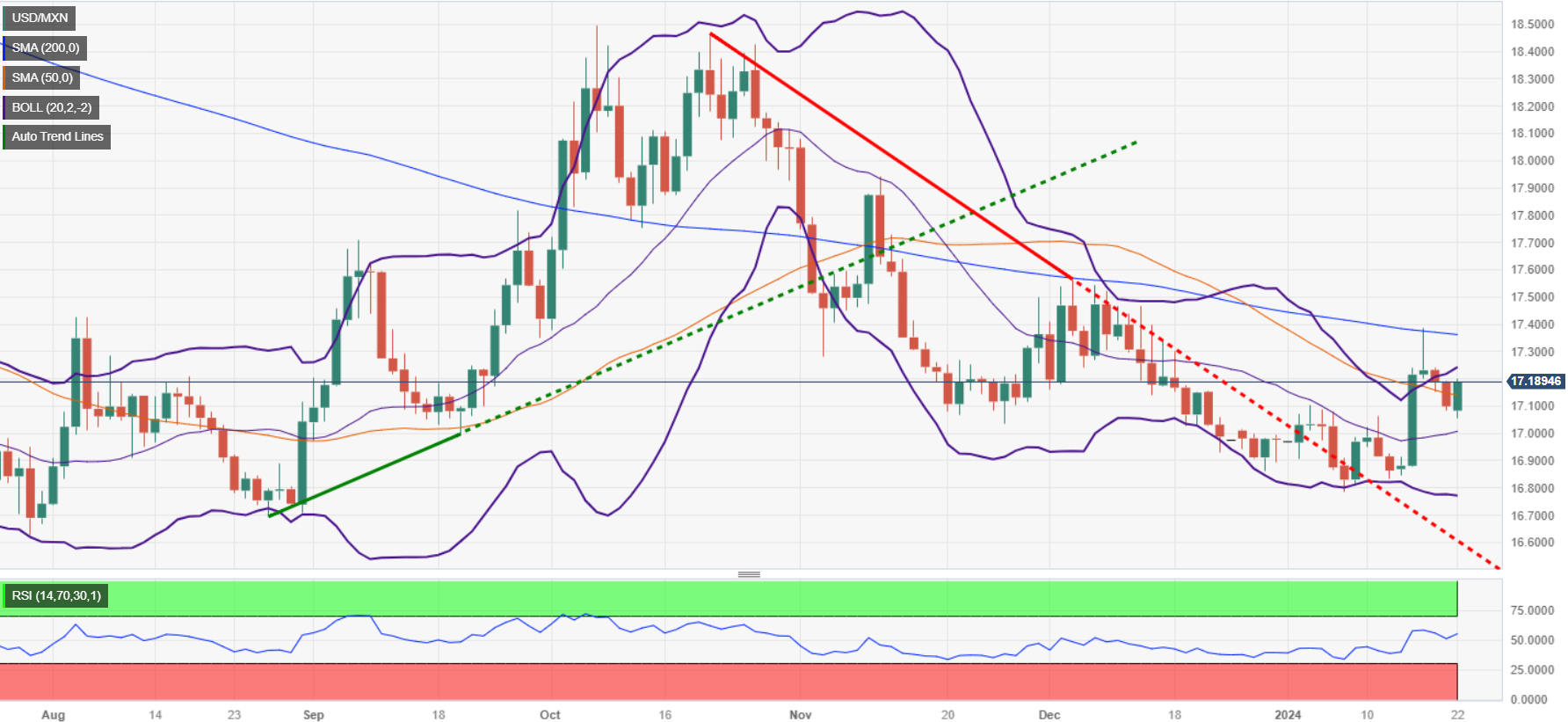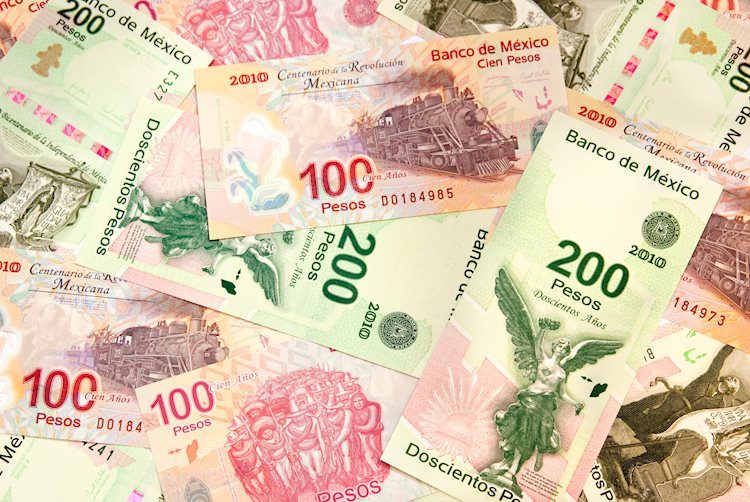Mexican Peso tumbles against US Dollar as USD/MXN buyers step in
Most recent article: Mexican Peso tumbles amid risk aversion, high US yields
- Mexican Peso starts the session lower as the US Dollar Index (DXY) remains steady around 103.24.
- Despite Wall Street gains, USD/MXN fails to rally sharply due to improved risk appetite and lower US Treasury bond yields.
- Mexico’s economic docket is eyed by traders, expecting the release of Economic Activity and inflation data.
The Mexican Peso begins the Monday session on a lower note against the US Dollar (USD) due to the Greenback capping its earlier losses as shown by the US Dollar Index (DXY), which is virtually unchanged near 103.24. Alongside that, an improvement in risk appetite and falling US Treasury bond yields have deterred the USD/MXN from gaining ground to higher levels, with the pair trading at 17.18, up a decent 0.65%.
Wall Street prints solid gains, which would usually bolster the Mexican currency. Nevertheless, the lack of economic data in Mexico’s docket on Monday and Tuesday leaves traders leaning on data from the United States. Mexico’s calendar will gain traction on Wednesday with the release of the Economic Activity report, along with January’s mid-month inflation data.
In the meantime, Federal Reserve (Fed) officials are absent as they enter their blackout period ahead of the January 30-31 monetary policy meeting.
Daily digest market movers: Mexican Peso on the defensive with traders awaiting further data
- In the meantime, former Bank of Mexico (Banxico) Deputy Governor Everardo Elizondo commented that it’s too soon to relax monetary policy in Mexico, adding, “There are enough reasons to remain worried.” Elizondo argued, "If [policy] is loosened, inflationary expectations will deteriorate.”
- Mexico’s latest economic data points to the economy slowing down as Retail Sales missed the forecast and trailed October’s data. At the same time, the economy is expected to grow by 2.6%, below forecasts of 3%.
- On the US front, last week’s economic data paints a soft-landing outlook. Even though housing data was mixed, American household sentiment improvement and lower inflation expectations underpinned the USD/MXN.
- Atlanta GDPNow model suggests last year’s Q4 would likely expand by 2.4%, spurred by strong retail sales, firm industrial production, a tight labor market and consumer sentiment improvement.
- Traders trimmed their bets for a dovish Federal Reserve in 2024. They stand at 142 basis points (bps) of cuts from 175 bps last week.
- The strongest catalyst last week was Federal Reserve Governor Christopher Waller’s speech: “No reason to move as quickly or cut as rapidly as in the past.” This kept investors in check despite Waller supporting rate cuts if inflation indeed gets lowered.
- Mexico witnessed a jump in headline inflation, but core data suggests the Bank of Mexico (Banxico) has done a good job, curbing elevated prices after hiking rates toward 11.25%.
- Despite indications from the December meeting minutes of Banxico (the Central Bank of Mexico) that it may consider easing its monetary policy, the inflation report for December poses a potential obstacle to any such policy relaxation.
- Standard Chartered analysts estimate the Bank of Mexico (Banxico) will lower rates to 9.25% in 2024.
- On January 5, a Reuters poll suggested the Mexican Peso could weaken 5.4% to 18.00 per US Dollar in the 12 months following December.
Technical analysis: Mexican Peso remains soft as USD/MXN meanders around 50-day SMA
The USD/MXN daily chart shows the pair is strengthening, testing the 50-day Simple Moving Average (SMA) at 17.15, ahead of a key resistance level at the 200-day SMA at 17.36. Further upside is seen once those levels are taken, followed by the 100-day SMA at 17.42 and 17.50. A breach of the latter will expose the May 23 high of 17.99.
On the flip side, if sellers cap the exotic pair from reclaiming the 50-day SMA, that would expose the pair to further losses. The first support would be the January 22 low of 17.05, the figure at 17.00, and the January 12 cycle low seen at 16.82.
USD/MXN Price Action – Daily Chart

Central banks FAQs
What does a central bank do?
Central Banks have a key mandate which is making sure that there is price stability in a country or region. Economies are constantly facing inflation or deflation when prices for certain goods and services are fluctuating. Constant rising prices for the same goods means inflation, constant lowered prices for the same goods means deflation. It is the task of the central bank to keep the demand in line by tweaking its policy rate. For the biggest central banks like the US Federal Reserve (Fed), the European Central Bank (ECB) or the Bank of England (BoE), the mandate is to keep inflation close to 2%.
What does a central bank do when inflation undershoots or overshoots its projected target?
A central bank has one important tool at its disposal to get inflation higher or lower, and that is by tweaking its benchmark policy rate, commonly known as interest rate. On pre-communicated moments, the central bank will issue a statement with its policy rate and provide additional reasoning on why it is either remaining or changing (cutting or hiking) it. Local banks will adjust their savings and lending rates accordingly, which in turn will make it either harder or easier for people to earn on their savings or for companies to take out loans and make investments in their businesses. When the central bank hikes interest rates substantially, this is called monetary tightening. When it is cutting its benchmark rate, it is called monetary easing.
Who decides on monetary policy and interest rates?
A central bank is often politically independent. Members of the central bank policy board are passing through a series of panels and hearings before being appointed to a policy board seat. Each member in that board often has a certain conviction on how the central bank should control inflation and the subsequent monetary policy. Members that want a very loose monetary policy, with low rates and cheap lending, to boost the economy substantially while being content to see inflation slightly above 2%, are called ‘doves’. Members that rather want to see higher rates to reward savings and want to keep a lit on inflation at all time are called ‘hawks’ and will not rest until inflation is at or just below 2%.
Is there a president or head of a central bank?
Normally, there is a chairman or president who leads each meeting, needs to create a consensus between the hawks or doves and has his or her final say when it would come down to a vote split to avoid a 50-50 tie on whether the current policy should be adjusted. The chairman will deliver speeches which often can be followed live, where the current monetary stance and outlook is being communicated. A central bank will try to push forward its monetary policy without triggering violent swings in rates, equities, or its currency. All members of the central bank will channel their stance toward the markets in advance of a policy meeting event. A few days before a policy meeting takes place until the new policy has been communicated, members are forbidden to talk publicly. This is called the blackout period.
Forex News
Keep up with the financial markets, know what's happening and what is affecting the markets with our latest market updates. Analyze market movers, trends and build your trading strategies accordingly.
